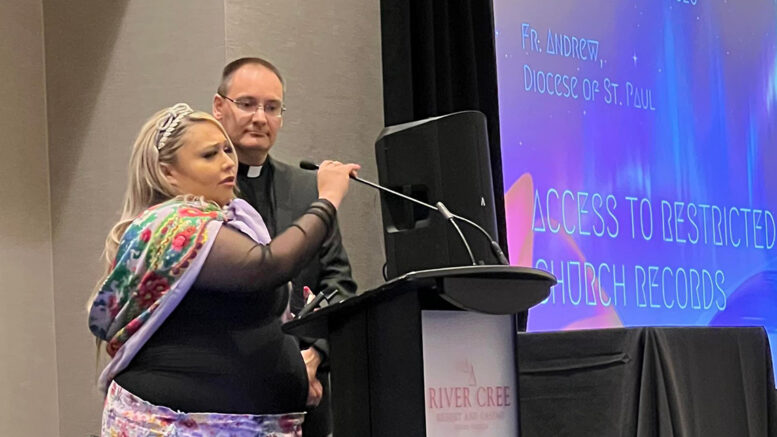by Kinnukana, Local Journalism Initiative Reporter
(ANNews) – The Acimowin Opaspiw Society (AOS) Investigation Methodologies National Symposium took place on September 26-28, 2023, at the River Cree Resort in Edmonton, Alberta. At the symposium, participants were provided with a presentation entitled: Access to Restricted Church Records, by Leah Redcrow, the Investigation Director of the Blue Quills Missing Children and Unmarked Burials Inquiry and Chief Executive Officer of AOS.
Additionally, presenting alongside her was Father Andrew Schoenberger, Director of the Saint Paul Cathedral in St. Paul, Alberta. The AOS has a Reconciliation Partnership with the St. Paul Diocese with a common goal to share restricted records of the church in order to locate children’s burial locations.
Redcrow stated in her presentation that Church (a clergy of a religious body, such as the Roman Catholic Church for example) records are an important source of information for life events such as births, baptisms, marriages, deaths and burials. In Canada, there is no central repository for church registers. Many of the records are in the custody of individual churches, genealogical societies, religious archives and provincial and territorial archives and libraries.
Furthermore, Redcrow emphasized that access to restricted church records is critical to Indigenous organizations leading investigations into the unmarked graves of First Nation children at residential school sites across Canada. Reason being, that most sites had unregistered cemeteries associated with them and the locations of many burial sites of residential school children have been lost.
It is estimated that there are approximately 1,900 unaccounted individuals, mostly children, who were recorded as having been registered to an Indian Residential School.
Redcrow said that the records are key in helping investigators locate children’s burial locations, as every residential school had a “home parish” where the life events of students were recorded. Even after a child passed away, the register book would follow their life and record the date of death and may even have the cause of death. In Redcrow’s presentation, she informed participants that the home parish never changes and the register always remains with the one church, or home parish. Each home parish also has its own assigned Diocese under the pastoral care of a bishop responsible for keeping records, which in the AOS’ case is Father Andrew Schoenberger.
In addition to this, Redcrow explained that the Church has numerous restricted records in different formats. The clergy has a comprehensive sacramental register that has its parishioners’ names, births, baptisms, deaths, etc. In the past, clergy also used historical codices to record what was happening each day and to document history. However, the documents between the Church and the Residential Schools may be different depending on the locations and whether or not they were under the same supervision. Moreover, many of these documents are narrative-like, while some are like daily logs or even journal entries. The stylistic choice of the codices really depends on the pastors who authored their own reports. Other key documents include Human Resource Records because they show if there were any conflicts with the staff of the schools. Many of these documents were written either in English, French or the language of the community.
In her presentation, Redcrow stated that the sacramental registry must be read in conjunction with the historical codices in order to understand what was going on in the community at the time. Leah said, “You must look at all these multiple records in order to build the stories and create a proper understanding of what happened to each child.”
Father Andrew also said during the presentation, that “these records don’t get destroyed under any circumstances and the Church has been keeping them for many years. The only way records are destroyed is if there is a fire where they are being held.”
Unlike the AOS, many Indigenous groups are struggling to access these documents for their investigations. There is no clearly defined process for accessing these records. The Church also says it has legal obligations that it must follow in order to protect parishioners, as per access to information and privacy legislation in Canada. Also, due to the heavy volume of inquiries the Church is receiving and the lack of resources they have, they are unable to conduct searches for everyone.
Father Andrew stated that “the Canadian Bishops have committed to Reconciliation with Indigenous People. The role of the church is to listen to the stories of Survivors and Indigenous communities and to be able to pray with them, for them, and assist where we can, to make amends for the errors of the past.”
He also recommends that Indigenous communities form collaborative approaches with the Church and work with each Diocese to determine what process could best work for each investigative group.
It has been over a year since Pope Francis’ Papal visit to Canada and his apology to Residential School Survivors. On July 25, 2023, the one-year anniversary of the apology, the Confederacy of Treaty No. 6 Nations released a statement from the Grand Chief and Chiefs of Treaty No. 6 Territory. In the statement, Leonard Standingontheroad, Grand Chief and Chief of Montana First Nation, stated, “It’s been a year since the visit with very little progress to show for it.” Alexander First Nation Chief George Arcand Jr said, “the apology was a meaningful first step from Pope Francis, but it wasn’t supposed to end there.”
Indigenous leaders want to see more action by the Church, and this is a necessary area that should be focused on immediately to assist the investigations and support the healing of Survivors. The Church should develop a process for easier access to these records and provide resources for each site in order to properly share restricted Church records. This is critical for moving forward on Reconciliation with Indigenous people.



Be the first to comment on "Access to church records critical to investigating children’s burial locations at Residential Schools"